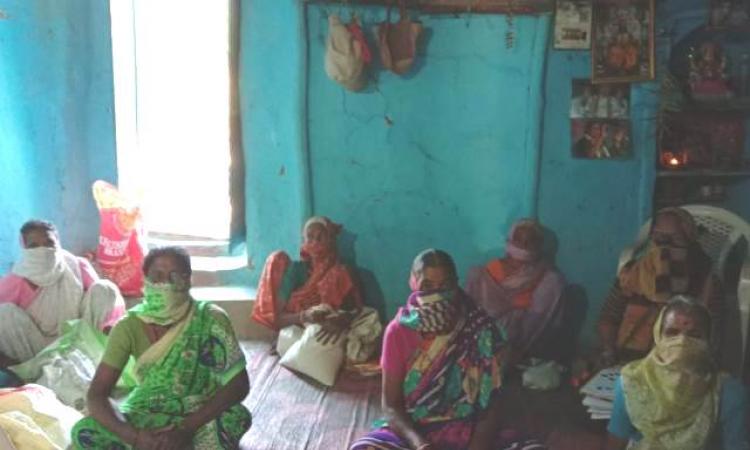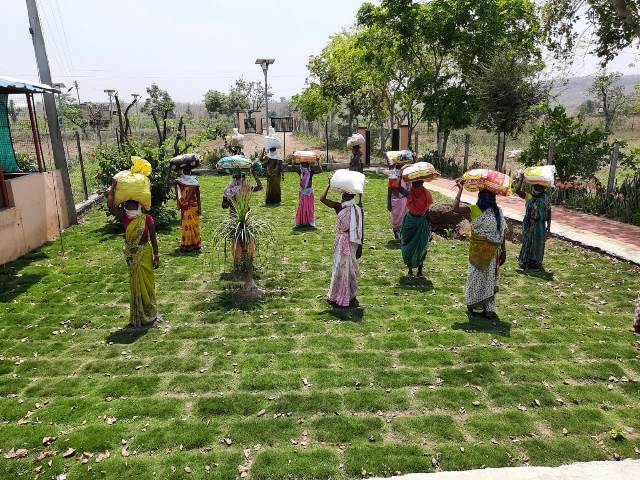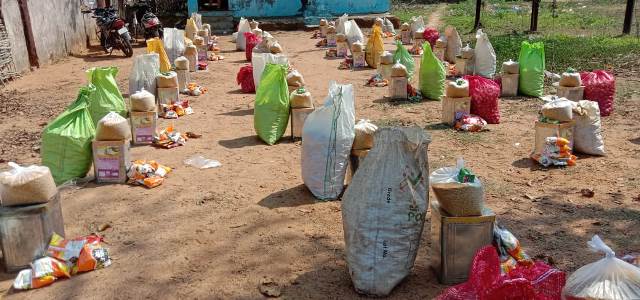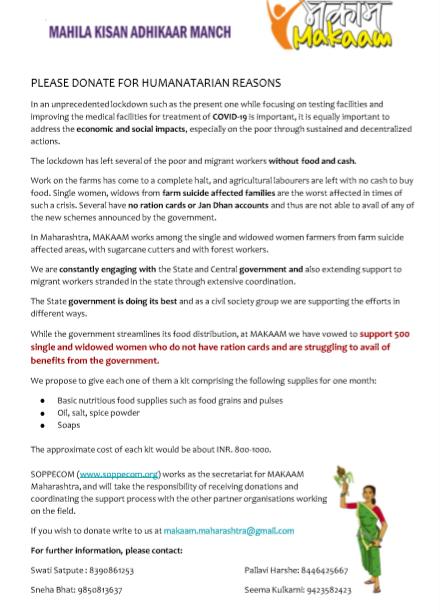
While the Covid-19 pandemic has wreaked havoc worldwide, India continues to be in the line of fire. While cases continue to rise, India also is experiencing a crisis of another kind, that of the lockdown affecting the livelihoods of a huge number of farm migrants working in cities. Not only has the lockdown caused immense suffering for migrants, it has worsened the situation of women who have been left with no food, water, shelter and means of subsistence.
Seema Kulkarni, a senior fellow at Society for Promoting Participative Ecosystem Management (SOPPECOM) and National Facilitation team member at Mahila Kisan Aadhar Manch (MAKAAM) speaks to the India Water Portal on her experiences of working with farm women in the drought affected state of Maharashtra, the situation of farm women in India and the effect of the current Covid-19 crisis on farm women.
What has been the role of women historically in agriculture and how has it changed now? What is the extent of participation of women in agriculture in India/Maharashtra?
Women have a strong presence in farming activities, however the main question is whether their work is being counted or not. Women’s work ranges from seed management to harvesting and post harvesting activities. However, several changes are taking place. In Maharashtra for example, in some of the more prosperous areas where irrigation is available, we are finding that women are moving into dairying while their traditional role in seed management has reduced. The agricultural paradigm of high external inputs, chemical and pesticide intensive agriculture along with introduction of GM varieties of seeds and mechanisation have also meant that women have lost out on their traditional jobs.
However, women farmers are also seen to be adapting to these new roles and we are also seeing women in managerial roles in some of these areas. For example in grape, pomegranate cultivation and floriculture we are seeing women take on key roles of supervision of labour, spraying of chemicals and pesticides, entering into markets etc. Single women in drought prone areas are also seen negotiating in the market economy just as they are engaged in local weekly markets. These transitions need to be studied and MAKAAM hopes to do such a large scale study in the near future.
However, while we do see a lot of presence of women in different activities and a diversification of their portfolios, their work continues to be unaccounted for. Feminist economists are raising the issue of measurement and accounting of women’s work and arguing for laying out better mechanisms for measuring and accounting women’s work.
Let us look at three datasets which give us a somewhat mixed picture of rural women’s work. Census 2011 shows that there has been a 24 percent increase in the number of female agricultural labourers, from 49.5 million in 2001 to 61.6 million in 2011. However, the decadal comparison of the Census data shows a fall in the category of women as cultivators, indicative of a loss of access to cultivable agricultural lands. Census 2011 for India shows that out of total females counted as Workers, 65.1 percent are engaged in agriculture.

The second data set is the Agricultural Census, which is less reliable when it comes to counting land ownership. The latest Agricultural census (2015-2016) cites that “the percentage share of female operational holders has increased from 12.79 per cent in 2010-11 to 13.87 per cent in 2015-16". In terms of operated area, the share of women increased from 10.36 percent to 11.57 percent.”
Moving to the NSSO data sets, we see that in the age group (25-59), rural women’s work to population ratios (WPR) fell from 58 percent to 48 percent between 2004-5 and 2011-12, and to 32 percent in 2017-18. Among rural women, the largest decline seems to have taken place in women categorised as unpaid family helpers — from 28 percent in 2004-5 to 12 per cent in 2017-18. In contrast, women counted as focusing solely on domestic duties increased from 21 per cent to 45 percent.
In Maharashtra women form 40 percent of the cultivators and 50 percent of the agricultural labourers as per Census 2011. Census also shows that of all the men workers 23 percent are cultivators and 30 percent are agricultural labourers. However, percentage of women involved as cultivators and agricultural labourers is slightly higher than men – 30 percent and 40 percent respectively.
All of these data sets point to the fact that women’s paid labour in agriculture is declining but their presence is perhaps increasing. This may vary from region to region and needs to be backed by large scale studies at the primary level.
What in your experience is the status of farm women in India/ Maharashtra in terms of the work they do, their health, rights etc? How has the agricultural crisis and droughts in Maharashtra affected farm women over the last few years? How are they trying to cope with it?
One of the main issues is that rural women are not recognised as workers and as farmers. despite their presence in agriculture. In rural India, ownership to cultivable land and access to irrigated land determines economic and social well being. Women’s lack of ownership to land has critical implications on their wellbeing as their access to land, water, forests, livestock and other resources and is largely mediated through men and the State.
Land ownership is considered as an important criterion for the design and delivery of a range of schemes in agriculture and irrigation thereby excluding women across social groups from a sector where their presence is the highest. Implications are seen by way of lack of budgets for rural women farmers and workers, specially targeted schemes or programmes for example, lack of access to PM Kisan Sanman scheme is one such example.
At the ground level thus, we see women managing fallow lands while men are forced to out-migrate in search of work, managing the farms with no water or credit for farm inputs and facing the brunt of both the agrarian crisis as well as that of caste and patriarchy. Most of women’s work continues to be unpaid, which is rising over the years. Among cane cutters, non-contractual obligations of patronage force women and children to work outside of the wage relation. Advances given compel women and children to put in the extra hours of work to meet the demands of the employer.
In the water stressed district of Ahmednagar, Maharashtra there were several instances where the employers commanded the right to use family labour for their own work, simply because they were providing water to the labourers. The deepening of the agrarian crisis has also meant that women are spending more time on the fields to save on expenses for hiring labour. In villages in Marathwada, the traditional systems of shared labour or Savad appear to be on the rise. In this system, women work on each other’s farms to save on expenditures related to hiring of labour. This has implications on the landless who probably have reduced opportunities for employment in their own villages and are forced to migrate seasonally or permanently.
Maharashtra which accounts for the largest number of farm suicides has a large number of women farmers who are widows. Denied any rights over resources and with the stigma and financial liabilities that they have to deal with, their plight is even worse.
However, we do have numerous stories from the field that demonstrate the agency of women to rise under these harsh conditions. They are organising, fighting for land rights and for entitlements from government and are rebuilding their own lives. Many are also hoping to make a transition to low external input or organic farming. The plight of sugarcane cutters is a matter of concern and we are working on the issue. A large-scale survey of about a 1000 women cane cutters shows the abysmal health conditions of these women and increasing gynaecological morbidity. Poor access to public health services at the work site and poor living conditions are a matter of much concern.

The Beed hysterectomies issue highlighted the poor health and the exploitative conditions under which women cane cutters work. The story may be similar to many other migrant women workers as well. Most of these women would prefer to work in their own villages if work was available. Whether it is public health, PDS or the NREGS, the plight of rural women across social and economic groups points to a failure of public policies and programmes.
The less discussed issue however is the violence meted out against rural women at work sites and in public spaces in general. The everyday violence meted out to migrant women, agricultural labourers is less documented and made visible. Women narrate numerous stories of how direct and indirect forms of violence are meted out to them when they try and access government schemes such as that of minimum support price. Migrant women in cane cutting, brick kilns, women from dalit, adivasi and nomadic tribes are constantly exposed to violence in myriad ways.
How do you think has covid further affected rural distress and the condition of men and women in the state? Are women affected differently than men? In what way?
Much has been written about the current Covid -19 crisis and its overall impact on the farming community, migrant workers and labour. In Maharashtra, we have numerous stories of strawberry farmers, floriculture and horticulture farmers being affected. This is harvest time for wheat, bananas grapes etc. Export of grapes has been affected. Lack of labour due to the lockdown has meant that farmers are not able to harvest their produce at full capacity. The harvested produce in turn has not been able to reach the markets due to problems of transportation which are now being streamlined. Procurement has thus become a major concern for farmers. However, There are positive stories of the MAHAFPC, which has decentralised procurement centres and is now procuring produce from the farmers.
Stranded migrant labour is facing problems related to food and other health conditions arising due to their living conditions. Sugar comes under the essential commodities and thus cane crushing is going on in full swing. But the cane cutters are not necessarily living in conditions that are demanded in the Covid -19 crisis. Physical distances are not maintained, hygiene is poor and work loads are heavy. Some of the cane cutters are stranded mid way with district and state boundaries sealed after the lockdown. Inter state migrants are in worse conditions and we all are witness to the harrowing stories about them.
Not much has been said about women. Only recently, we are seeing writings on the impacts of Covid -19 on women. Through a series of conference calls organised with Mahila Kisan Aadhar Manch (MAKAAM) partners and activists on the ground, it is evident that rural women are disproportionately affected due to the current crisis. Work has come to a complete halt in rural Maharashtra as elsewhere. With no wages in hand, most of the rural poor are struggling to make ends meet. The burden on single women, widowed women is especially high as they have relied entirely on daily wages through agricultural labour, Mahatma Gandhi National Rural Employment Guarantee Act (MGNREGAs), vegetable vending or other petty trades. Women engaged in livestock have not been able to move freely to graze their cattle and neither are they able to sell their produce. Their children depend on them for survival.
The foremost concern that is staring at them is lack of food supplies for the household. Many of these single women either do not have a separate ration card in their name or it is not aadhar seeded. This makes it difficult for them to access food supplies from the PDS. They thus are forced to resort to borrowing from shopkeepers that they have to return with interest at a later date or with other kinds of favours.
Weekly markets have shut down and these were the spaces where women often bought their vegetables or other produce to sell. Transportation is becoming difficult for bringing in their produce to make door to door sales. Women are demanding that some spaces be made available where they could sell their produce.
Although liquor is banned, men are now drinking more than before, gambling is on the rise and all of this has also led to increased violence against women. Women complain that police ignore overcrowding by men at liquor stalls and gambling sites, but they displace women vendors.
The Prime Minister through the Pradhan Mantri Garib Kalyan Yojna (PMGKY) has made several announcements for the rural poor. However, the help provided for single and widowed women is woefully inadequate with Rs 1000 to be given to widows and people with disabilities for a period of 3 months or Rs 500 per month for 3 months for 20 crore Jan Dhan account holders and free rice and dal over and above the regular ration quotas for all the NFSA beneficiaries. All of these have problems in access for rural women. Many do not have active Jan Dhan accounts so will have to struggle for it to get them activated. Does that mean visiting the bank or will the government proactively do something about it? Rs 333 permonth for widows is inadequate, especially if they are not ration card holders.
Employment seems like a distant possibility now with the lockdown being extended until the end of the month. Maharashtra government has added an additional difficulty for accessing the free rice scheme of the centre. It says that you need to buy your regular quota of ration before you could access your free quota. So, it translated into a buy one get one scheme which in times such as the present does not go down very well. We are also hearing stories from several women in rural areas, that the quotas of regular ration are also inadequate, the 35 kgs per family quotas are not being met. This has caused a deep distress among the rural poor, especially single and widowed women.
What is Makaam, what does it represent and how does it support farm women?
Mahila Kisan Adhikar Manch (MAKAAM) is a national network of more than 200 organisations and individuals that include women farmers and workers themselves. MAKAAM has been fighting for recognition and voice for women farmers and their rights to entitlements.
 It has a presence in more than 22 states of the country and actively engages with communities in about 14 states of the country. It has taken up a range of issues at the state and national level, especially related to forest rights, women farmers from suicide affected households, transition to ecological farming and women as champions for the same, issues of women cane cutters and other migrant labourers, land rights for women to include private property as well as State lands, claiming rights to ceiling surpluses and other state lands for dalit and adivasi women. It supports the cause of rural farm women engaged in agriculture and allied activities, through research, policy engagement with governments, campaigns, public hearings, consultations, media outreach etc.
It has a presence in more than 22 states of the country and actively engages with communities in about 14 states of the country. It has taken up a range of issues at the state and national level, especially related to forest rights, women farmers from suicide affected households, transition to ecological farming and women as champions for the same, issues of women cane cutters and other migrant labourers, land rights for women to include private property as well as State lands, claiming rights to ceiling surpluses and other state lands for dalit and adivasi women. It supports the cause of rural farm women engaged in agriculture and allied activities, through research, policy engagement with governments, campaigns, public hearings, consultations, media outreach etc.
In the current Covid -19 crisis, we are reaching out to about 600 single and widowed women across 14 districts of Maharashtra with basic kits of food supplies. The food and soap kit includes not just the wheat and rice cereals that are part of the existing PDS, but also pulses that are grown locally and onions and potatoes as well. We know that this is a drop in the ocean, but we do hope that this can support the women at least until the government is able to streamline its processes of food distribution.
Currently MAKAAM is working at two levels, one is by way of providing direct relief to women and second is to engage with the government to streamline the schemes that it has announced recently and also to chart a course for the post lockdown period.
What needs to be done on an urgent basis to help women migrants in cities who have been left without food, water and any other system of support?
For both women migrants in cities and for rural women, a clearly worked out plan needs to be in place. In the immediate it is important to provide cooked meals and shelters for stranded migrants in the cities. Maharashtra government has announced some schemes towards this. The extension of Shiv Bhojan Thalis to smaller towns is welcome, but it cannot reach the rural areas. The thalis need to be provided free of cost for migrants who are stranded in the cities without any cash in hand. Like in the states of Delhi, Telangana etc, migrants should be given free food. In rural areas where cooked meals cannot reach, it is important to provide adequate amounts of free ration supplies until they are able to tide over the crisis.
For rural single and widowed women in Maharashtra, MAKAAM has raised an appeal for people to support. Please support the cause and contribute towards the basic food supplies for women. Currently the State network is anchored by Society for Promoting Participative Ecosystem Management (SOPPECOM).
Please download the details of MAKAAM and the help they seek in English and Marathi from below: